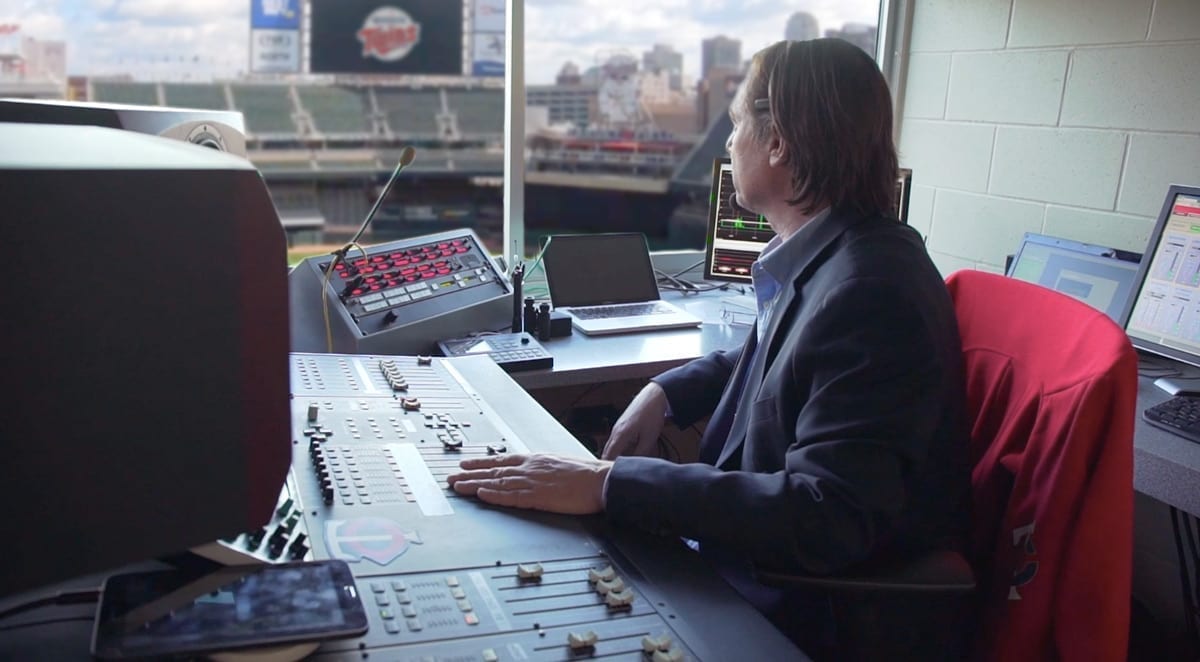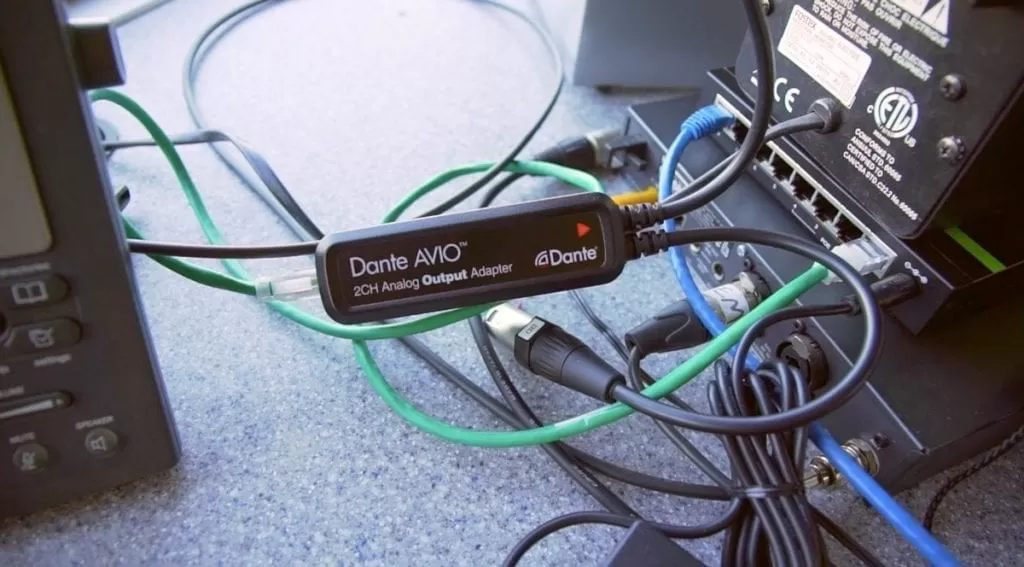Dante Domain Manager Hits a Home Run at Target Field

New audio network management software adds to MLB fan experience with reliable, efficient and secure AV streams for Minnesota Twins baseball games


Sitting in the heart of downtown Minneapolis, Target Field represents Minnesota’s dynamic blend of urban sophistication and outdoor vitality. This Major League Baseball stadium is home to the Minnesota Twins and accommodates more than 39,000 eager spectators ready to cheer on their team. Though designed as a baseball venue, it also hosts football, soccer, and a wide range of outdoor concerts and various non-sports-based corporate events.
The stadium is a three-tier grandstand that features club seats,
luxury suites, a press box and the Budweiser Roof Deck featuring a fire
pit, bar, city skyline view, bleacher seats and standing room.
The stadium’s premiere offerings extend beyond the seats as well. To
give those in attendance a truly incredible experience, the facility’s
business operations looked for ways it could deliver excellence across
all ballpark offerings. One area where this was critical was the
ballpark sound, which means high-quality audio is a major part of the
fan experience at Target Field.
Jeff Pedersen, Lead Audio Technician, Minnesota Twins Baseball,
manages and operates the sound systems and audio equipment for all games
and special events. Pedersen works closely with Tim Habedank, AV
Technical Manager, Parsons Electric, to manage and upgrade the stadium’s
audio system.
Target Field is a large venue and multiple areas around the facility
require Pedersen’s audio support. This can include distributing audio
out to various areas or pulling signals back to the control room for
mixing and processing. For example, live bands perform before ball games
and during breaks. Pedersen must be sure this audio is heard throughout
the stadium.
There are many different subnets in the facility and all audio
transport was previously occurring over the network using CobraNet.
While the CobraNet system is still in place to transport DSP audio data
over fiber to and from fixed locations, such as amp rooms, clubs and
press areas, the system reached its maximum capability and a new
solution was needed. Additionally, demand for a better fan experience
required adding audio in areas that were not originally planned for
audio support. To add audio to these sections, the stadium expanded with
Dante and Dante Domain Manager.
Creating a Dante Network
Pedersen needed a way to easily and inexpensively expand the number
of inputs and outputs to his main console to provide a better fan
experience, a better mix, and manage and control the total system. His
search led him to Dante. The natural next step was to install
Dante-enabled equipment, immediately upgrading the system by expanding
channel counts, expanding audio infrastructure and reducing latency.
Dante is a digital media networking technology allowing users send
uncompressed, multi-channel audio over a single Ethernet cable. It is
the de facto standard audio networking solution, and has been adopted by
more pro-audio AV manufacturers than any other networking technology,
making interoperability easy, reliable and a true reality. With Dante as
the networking solution, the team at Target Field can integrate audio
from a wide range of audio devices from multi-vendor manufacturers.
Dante also allows Target Field to tap into the existing networking
structure of the field, without having to install extra infrastructure
to get audio where it needs to go. Pedersen added wireless microphone
receivers, mixers and input/output racks as a base for his Dante system.
Prior to Dante, Pedersen was limited by its CobraNet system – it was
simply maxed out. With a Dante system in place, Target Field now has
more than enough audio channels available.
“We would have a band performing on the other side of the stadium,
and there was very limited connectivity, so I could only get two audio
lines to use: one for an intercom connection so we could communicate
with our technician located with the band, who would then send me a
sub-mixed signal back on the other audio line,” said Pedersen. “We were
able to get the job done, but it was a difficult process to say the
least. My dream was to have control of all of this in front of me on my
console, with separate channels for mixing. I finally got to do this by
adding Dante connectivity into the system.”
The stadium’s audio system consists of a control room tied to
multiple locations. There are three amplifier rooms supporting the
stadium speaker system, as well as 18 other locations that receive audio
feeds from the control room.
“We started by using Dante to connect the control room to the band
stage, and this step alone brought 16 channels from the band to my main
console – a huge improvement for us,” said Pedersen. “Our plan now is to
get Dante into all of our remote locations and bring all the control
and mixing to our main control room.”
Pedersen also frequently uses a portable sound system, a small rack with a digital mixer, amplifiers and wireless connectivity.
“If we need more remote support, I can easily plug in a network cable
and jump on the Dante network to my console,” said Pedersen. “There’s a
lot of flexibility now in being able to share inputs and outputs with
different mixers in different areas.”
A Dante system allows endless audio possibilities for the stadium, as
hundreds of Dante-enabled products are available and interoperable.
Pedersen can now mix any Dante-enabled speaker, amplifier, microphone,
mixer, receiver, converter and more. And, with the addition of Dante
AVIO Adapters, the stadium can integrate older, legacy gear into Dante
systems, adding to Dante’s interoperability and flexibility.
Managing the Domains
With a Dante system in place, Dante Domain Manager proved to be a
natural next step to the network, as it added the control and security
features the stadium desired. Dante Domain Manager is network management
software that enables user authentication, role-based security and
audit capabilities for Dante networks, while allowing seamless expansion
of Dante systems over any network infrastructure. Dante Domain Manager
allowed the stadium to integrate the many separate subnets into a
single, manageable and secure audio network.
For game producers to add to the fans’ game experience, Pedersen and
Habedank needed to integrate audio into areas of the stadium that were
not originally designed for audio, such as where the live band plays.
Instead of adding an audio pathway and thousands of dollars of cabling,
they used an existing data drop at these new locations, adding a Dante
input/output box and plugging it into the network. However, these new
locations were not on the same subnet as Pedersen’s control room. With
some configuration and help from the stadium’s experienced IT
department, Dante Domain Manager stepped in to bridge the various
subnets, easily passing Dante audio from the new locations back to the
control room.
“At Target Field, they have a Layer 3 network at the closet, so that
means every closet has its own subnet. The control room on the opposite
side of the stadium was in a different subnet than the live band
location,” said Habedank. “Dante Domain Manager allows us to bridge
these subnets and pass Dante from one corner of the stadium all the way
back to the control room and really save the day without all of that
cost of cabling.”
On the network level, Dante Domain Manager provides the ability to
scale and segment audio networks, regardless of the physical constraints
of the network. Administrators can define specific AV device groupings,
by room, building and site, ensuring the stadium’s audio is playing in
the correct location.
Target Field works with network television broadcast trucks during
games. More and more, these production companies bring their own Dante
systems to connect into the stadium’s Dante system. Dante Domain Manager
ensures both the visiting and stadium’s audio channels are secure,
crisp and clear.
“We want to protect the house Dante network to make sure that no one
inadvertently makes changes,” said Habedank. “Without Dante Domain
Manager, that protection is not possible – we essentially open up our
whole Dante network to outside companies. But, with Dante Domain
Manager, we’re able to create those domains. Outside companies stay in
their domain, the house network stays in its domain, and we can bridge
the audio between those two as needed. That way we can still have a lot
of functionality and can pass as many audio channels back and forth as
we want, but we also maintain that protection of the house Dante
network.”
Dante Domain Manager ensures the stadium’s audio is separate from the
audio they grant the visitors to use, with robust user authentication
and role assignment. With Dante Domain Manager, Pedersen can be sure the
stadium’s audio runs smoothly and is free of unwanted changes and
modifications.
“Before Dante Domain Manager, what I wanted to do was not really
possible: the cost would have been prohibitive and the time spent
patching and running cables wasn’t feasible,” said Pedersen. “One of the
things I can do now is send 16 channels of audio to almost any place in
the stadium up to the control room. It is very liberating.”
As the system becomes larger and more complex, the Dante Domain
Manger dashboard helps engineers keep tabs on devices and user-made
changes. The dashboard provides the critical information with
at-a-glance reports, audit trails and SNMP-driven alerts. Additionally,
Dante Domain Manager steps in to fix problems with its error logging
feature that shows an issue and offers suggestions on how to fix it. Or,
Dante Domain Manager provides a suite of auto-configuration tools to
fix network issues automatically.
A Near-Perfect Audio Game Required
Pedersen explained that while he is currently limited to a 16×16
Dante-enabled console, a new console is in the upgrade plan and he looks
forward to expanded channel possibilities. He also wants to extend the
Dante network to the broadcast trucks.
“After our facility audio is completely networked, I want to move
toward Dante and Dante Domain Manager-managed audio with our broadcast.
Right now, we send the trucks a full audio program, and they return a
full program. We need to get to where we can send just selected channels
or sub mixes,” said Pedersen. “We’ve always had difficulty transferring
things back and forth from the trucks to our control room, and it
almost takes six people to do it. This whole process will be much easier
when the trucks can simply pull either the live or recorded audio of
what they need from our Dante audio network.”
Whether it is a concert, football game, soccer game or Major League
Baseball showdown, Dante and Dante Domain Manager deliver near-perfect,
near-zero latency audio to the more than 39,000 spectators. Target Field
administrators can rest easy knowing its network is secure and
efficient while delivering the live sound, recorded and broadcast audio
performances required to take fans out to the ballgame.



